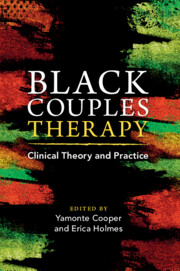Book contents
- Black Couples Therapy
- Black Couples Therapy
- Copyright page
- Contents
- Figures
- Tables
- Contributors
- Foreword
- Acknowledgments
- Introduction
- Part I Race, Racism, and Identity
- Part II Foundations for Healthy Coupling
- Part III Adapting Major Therapeutic Approaches for Work with African American Couples
- Part IV Sex and Intimacy
- Part V Special Topics
- Chapter 14 Weathering the Storm: Fertility and the Black Lesbian Experience
- Chapter 15 African American Men and Infertility: Biopsychosocial Considerations
- Chapter 16 Couples Therapy with Black American Couples Facing Medical Illness: Considerations for Treatment
- Index
- References
Chapter 15 - African American Men and Infertility: Biopsychosocial Considerations
from Part V - Special Topics
Published online by Cambridge University Press: 27 July 2023
- Black Couples Therapy
- Black Couples Therapy
- Copyright page
- Contents
- Figures
- Tables
- Contributors
- Foreword
- Acknowledgments
- Introduction
- Part I Race, Racism, and Identity
- Part II Foundations for Healthy Coupling
- Part III Adapting Major Therapeutic Approaches for Work with African American Couples
- Part IV Sex and Intimacy
- Part V Special Topics
- Chapter 14 Weathering the Storm: Fertility and the Black Lesbian Experience
- Chapter 15 African American Men and Infertility: Biopsychosocial Considerations
- Chapter 16 Couples Therapy with Black American Couples Facing Medical Illness: Considerations for Treatment
- Index
- References
Summary
Infertility is a reproductive health condition that is often not openly discussed. By not discussing this condition, many stigmas and stereotypes may be ascribed. For example, many think that infertility pertains only to women, although men may also receive an infertility diagnosis. Race and ethnicity can impact how male factor infertility is understood, communicated, and managed. The aim of this chapter is to synthesize available research regarding biopsychosocial variables of male factor infertility with African American men while offering support considerations.
Keywords
- Type
- Chapter
- Information
- Black Couples TherapyClinical Theory and Practice, pp. 329 - 347Publisher: Cambridge University PressPrint publication year: 2023



